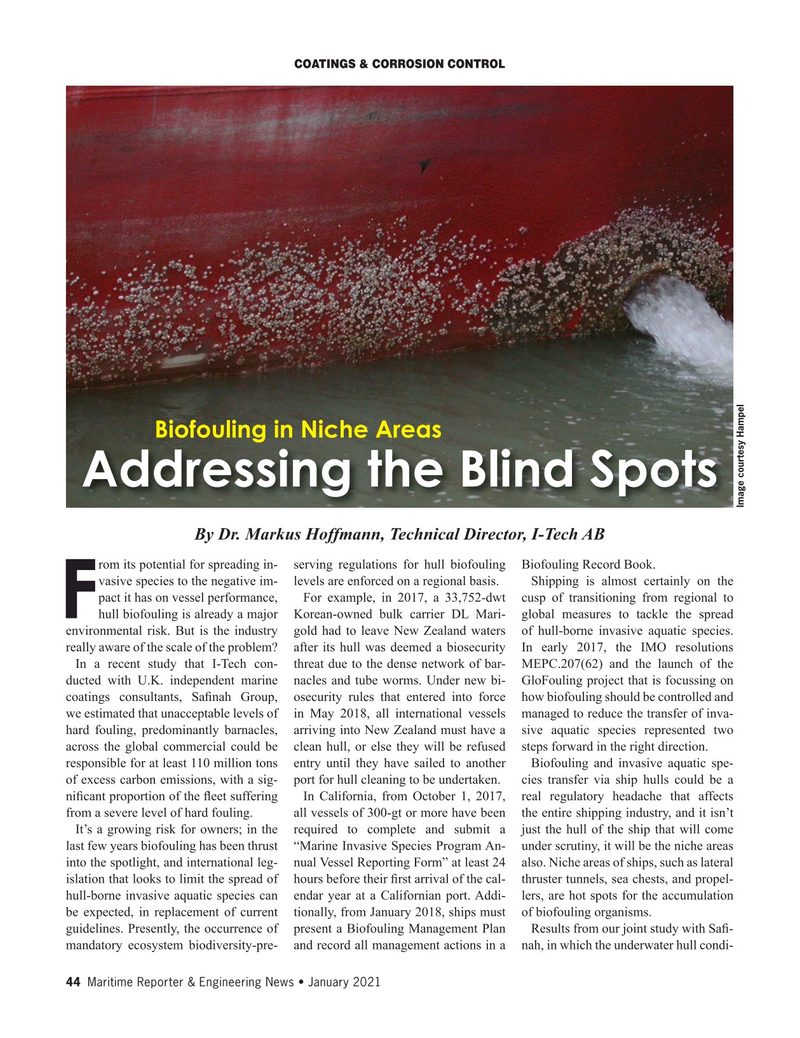
Page 44: of Maritime Reporter Magazine (January 2021)
The Ship Repair & Conversion Edition
Read this page in Pdf, Flash or Html5 edition of January 2021 Maritime Reporter Magazine
COATINGS & CORROSION CONTROL
Biofouling in Niche Areas
Addressing the Blind Spots
Image courtesy Hampel
By Dr. Markus Hoffmann, Technical Director, I-Tech AB rom its potential for spreading in- serving regulations for hull biofouling Biofouling Record Book.
vasive species to the negative im- levels are enforced on a regional basis. Shipping is almost certainly on the pact it has on vessel performance, For example, in 2017, a 33,752-dwt cusp of transitioning from regional to
Fhull biofouling is already a major Korean-owned bulk carrier DL Mari- global measures to tackle the spread environmental risk. But is the industry gold had to leave New Zealand waters of hull-borne invasive aquatic species. really aware of the scale of the problem? after its hull was deemed a biosecurity In early 2017, the IMO resolutions
In a recent study that I-Tech con- threat due to the dense network of bar- MEPC.207(62) and the launch of the ducted with U.K. independent marine nacles and tube worms. Under new bi- GloFouling project that is focussing on coatings consultants, Sa? nah Group, osecurity rules that entered into force how biofouling should be controlled and we estimated that unacceptable levels of in May 2018, all international vessels managed to reduce the transfer of inva- hard fouling, predominantly barnacles, arriving into New Zealand must have a sive aquatic species represented two across the global commercial could be clean hull, or else they will be refused steps forward in the right direction. responsible for at least 110 million tons entry until they have sailed to another Biofouling and invasive aquatic spe- of excess carbon emissions, with a sig- port for hull cleaning to be undertaken. cies transfer via ship hulls could be a ni? cant proportion of the ? eet suffering In California, from October 1, 2017, real regulatory headache that affects from a severe level of hard fouling. all vessels of 300-gt or more have been the entire shipping industry, and it isn’t
It’s a growing risk for owners; in the required to complete and submit a just the hull of the ship that will come last few years biofouling has been thrust “Marine Invasive Species Program An- under scrutiny, it will be the niche areas into the spotlight, and international leg- nual Vessel Reporting Form” at least 24 also. Niche areas of ships, such as lateral islation that looks to limit the spread of hours before their ? rst arrival of the cal- thruster tunnels, sea chests, and propel- hull-borne invasive aquatic species can endar year at a Californian port. Addi- lers, are hot spots for the accumulation be expected, in replacement of current tionally, from January 2018, ships must of biofouling organisms.
guidelines. Presently, the occurrence of present a Biofouling Management Plan Results from our joint study with Sa? - mandatory ecosystem biodiversity-pre- and record all management actions in a nah, in which the underwater hull condi- 44 Maritime Reporter & Engineering News • January 2021
MR #1 (34-49).indd 44 1/7/2021 5:17:03 PM

 43
43

 45
45
